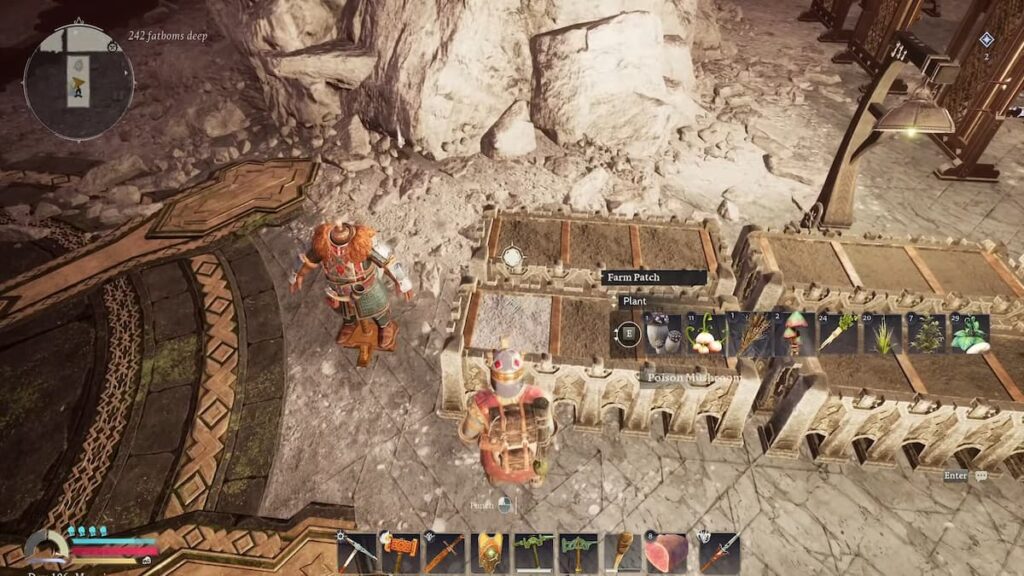
Image source: North Beach Games
Farming is a big part of survival in The Lord of the Rings: Return to Moria. One unlocked, it takes your dependency on resources away from having to scavenge for a steady supply of cooked food and rations. Here we’ll walk you through the process of unlocking farming in Moria, understanding the mechanics, and detail a full list of all the seeds/crops in the game.
How to Unlock Farming in Return to Moria

You won’t be able to unlock farming near your camp until later in the game when you start heading down to the Lower Deeps. As we’ve detailed in our guide on Ubasam Wood, to get to the Lower Deeps you and your co-op buddies will need to repair the Crystal Descent by gathering a few different resources.
Once you’re there, you’ll need to gather two necessary resources:
- Ihraz Granite: You can locate Ihraz Granite in the Lower Deeps and below on the map.
- Bat Droppings: These can be obtained by defeating bats anywhere in Moria.
Once you’ve acquired these items, you’ll unlock new building recipes, allowing you to construct a Farm Patch or Farm Box in any of your camps.
While unlocking your own farm is preferable, there’s also the option of utilizing pre-existing Farm Patches found near Dwarven homes throughout Moria. These patches can be especially useful if you decide to establish a base there. Even without a camp, you can plant crops in these patches, so be sure to make good use of them.
How to Farm & What Light/Dark Crops Are

Farming in The Lord of the Rings: Return to Moria is relatively straightforward once you’ve unlocked it. You start by constructing a Farm Patch or Farm Box in your camp, then simply plant crops from your inventory.
Given that you’re literally down a mine, obviously farming is slightly different from the outdoor farming you’re used to in other games. In Moria, crops can either be grown in light or darkness, depending on what is suitable for that particular fauna. The Dwarves have adapted to cultivate mushrooms, which don’t need light to grow. However, most other crops require light to thrive.
Importantly, placing a “dark” crop, such as mushrooms, in a well-lit area or a “light” crop in darkness will inhibit their growth.
Farm Patches are tagged as either “light” or “dark” based on their location, regardless of the actual light level. A full circle symbolizes that it provides enough light for light-dependent crops, while a half-full circle indicates it’s dark enough for mushrooms to grow. Artificial light sources like torches do not seem to affect this mechanic.
If you mistakenly plant the wrong crop, you can scroll down the menu to “uproot” it. This will destroy the planted crop and free up the Farm Patch or Farm Box for another crop. Be cautious when interacting with these structures, as it’s easy to accidentally plant the wrong crop.
Crops grow in stages, so you need to wait for them to reach maturity. A single seed or seed crop can eventually yield a maximum of four of the same crop. For example, planting one mushroom seed will eventually yield a maximum of four mushrooms.
Some crops can only be found as seeds. To grow Chive, Fennel, Mint, Thyme, and White Beans, you’ll need to find their respective seeds. Growing these plants can also unlock new cooking recipes.
Besides managing the light level, you don’t need to take any further action while waiting for your crops to grow.
All Crops in Return to Moria
Crops That Require Light
- Aule Bloom
- Cabbage
- Chive
- Chive Seeds
- Fennel
- Fennel Seeds
- Khuzdul Oat
- Mint
- Mint Seed
- Mountain Potato
- Parsnips
- Thanazutsam
- Thyme
- Thyme Seed
- White Beans
- White Bean Seed
Crops That Require Darkness
- Aberrant Cavecap
- Biteweed
- Deep Mushroom
- Mushroom
- Poison Mushroom
Crops That Are Not Growable:
- Cranberries
- Elbereth’s Blessing
- Grabapple
That wraps up our comprehensive Return to Moria farming guide. We’ve written similarly robust articles on resources in the game, as well as a starter guide if you’re a newcomer.





